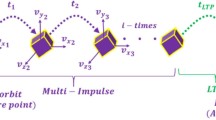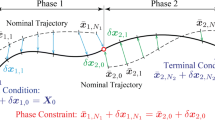Abstract
A spacecraft’s separation parameters directly affect its flying trace. If the parameters exceed their limits, it will be difficult to adjust the flying attitude of the spacecraft, and the spacescraft may go off-track or crash. In this paper, we present a composite optimization method, which combines angular velocities with external moments for separation parameters of large-eccentricity pico-satellites. By changing the positions of elastic launch devices, the method effectively controls the popping process under the condition of less change in the separation mechanism. Finally, the reasons for deviation of angular velocities and unreliable optimization results are presented and analyzed. This optimization method is proved through a ground test which offsets the gravity. Simulation and test results show that the optimization method can effectively optimize the separation parameters of large-eccentricity pico-satellites. The proposed method adapts particularly to the fixed and non-stable status elastic parameters, the distribution of all kinds of elastic devices, and large-eccentricity spacecrafts for which attitude corrections are difficult. It is generally applicable and easy to operate in practical applications.
Similar content being viewed by others
References
Chao J, Wang ZK, Zhang YL, 2015. Development of the new approach of formation initialization using spring separation mechanism considering J2 perturbation. Adv Space Res, 55(11):2616–2627. https://doi.org/10.1016/j.asr.2015.02.019
Cui DL, Yan SZ, Li JL, et al., 2014. Dynamic analysis of satellite separation considering the flexibility of interface rings. J Aerosp Eng, 229(10):1886–1902. https://doi.org/10.1177/0954410014562012
Cui DL, Zhao JL, Yan SZ, et al., 2015. Analysis of parameter sensitivity on dynamics of satellite separation. Acta Astronaut, 114(3):22–33. https://doi.org/10.1016/j.actaastro.2015.04.007
Fritz M, Berger PD, 2015. Can you relate in multiple ways? Multiple linear regression and stepwise regression. In: Kaufmann M (Ed.), Improving the User Experience Through Practical Data Analytics. Elsevier Inc., Boston, p.239–269. https://doi.org/10.1016/B978-0-12-800635-1.00010-0
Hu J, Li HC, Zhou YP, 2012. The application of Levenberg- Marquardt algorithm in the image stitching. Telecom Mark, 2:149–154 (in Chinese). https://doi.org/10.3969/j.issn.1006-6675-B.2012.02.049
Hu XZ, Chen XQ, Tuo ZH, et al., 2013. Dynamics and transient perturbation analysis of satellite separation systems. Proc Inst Mech Eng G, 227(12):1968–1976. https://doi.org/10.1177/0954410012466780
Hu XZ, Chen XQ, Zhao Y, et al., 2014a. Optimization design of satellite separation systems based on multi-island genetic algorithm. Adv Spac Res, 53(5):870–876. https://doi.org/10.1016/j.asr.2013.12.021
Hu XZ, Chen XQ, Tuo ZH, et al., 2014b. Simplified metrics of elastic potential energy for spacecraft separation dynamics. Acta Astronaut, 102:151–155. https://doi.org/10.1016/j.actaastro.2014.05.028
Hu XZ, Chen XQ, Zhao Y, et al., 2017. Active subspace approach to reliability and safety assessments of small satellite separation. Acta Astronaut, 131:159–165. https://doi.org/10.1016/j.actaastro.2016.10.042
Huang WH, Cao DQ, Han ZY, 2012. Advances and trends in dynamics and control of spacecrafts. Adv Mech, 42(4): 367–394. https://doi.org/10.6052/1000-0992-11-171
Iwasa T, Shi Q, Ando S, et al., 2007. Simplified SRS prediction method for pyroshock source of V-band clamp separation devices. 48th AIAA/ASME/ASCE/AHS/ASC Structures, Structural Dynamics, and Materials Conf, p.1–12. https://doi.org/10.2514/6.2007-2020
Jiang C, Wang ZK, Zhang YL, 2015. Angular velocity depressing method of constrained and centroid biased on-orbit separation. Acta Aeronaut Astronaut Sin, 36(10): 3382–3392 (in Chinese). https://doi.org/10.7527/S1000-6893.2015.0093
Jing C, Wang ZK, Fan L, et al., 2010. Dynamics analysis of the constrained and centroid biased on-orbit satellite separation. Flight Dynam, 28(1):76–79 (in Chinese). https://doi.org/10.13645/j.cnki.f.d.2010.01.014
Lan W, Brown J, Toorian A, et al., 2006. CubeSat development in education and into industry. AIAA SPACE Forum, Article 7296. https://doi.org/10.2514/6.2006-7296
Leng JF, Gao X, Zhu JP, 2016. Application of multivariate linear regression statistical prediction model. Stat Dec, 7:82–85 (in Chinese). https://doi.org/10.13546/j.cnki.tjyjc.2016.07.021
Li JL, Yan SZ, Tan XF, 2012. Modeling and simulation of clamp band dynamic envelope in a LV/SC separation system. Appl Mech Mater, 141:359–363. https://doi.org/10.4028/www.scientific.net/AMM.141.359
Li JL, Yan SZ, Tan XF, 2014. Dynamic-envelope analysis of clamp-band joint considering pyroshock of satellite separation. J Spacecr Rock, 51(5):1390–1400. https://doi.org/10.2514/1.A32382
Michaels D, Gany A, 2016. Modeling and testing of a tube-in-tube separation mechanism of bodies in space. Acta Astronaut, 129:214–222. https://doi.org/10.1016/j.actaastro.2016.09.013
Miyamoto K, Ui K, Miyashita S, et al., 2005. Tokyo tech separation demonstration TSD as M-V rocket sub-payload for nanosatellite separation mechanism. 56th Int Astronautical Congress of the Int Astronautical Federation, the Int Academy of Astronautics, and the Int Institute of Space Law, Article IAC-05-B5.6.A. https://doi.org/10.2514/6.IAC-05-B5.6.A.03
Paris C, 2015. Vibration tests on the preloaded LARES satellite and separation system. Aerosp Sci Technol, 42: 470–476. https://doi.org/10.1016/j.ast.2015.01.023
Qin ZY, Yan SZ, Chu FL, 2009. Axial stiffness analysis of clamp band system. J Astron, 30(5):2080–2085 (in Chinese). https://doi.org/10.3873/j.issn.1000-1328.2009.05.056
Qin ZY, Yan SZ, Chu FL, 2010. Dynamic analysis of clamp band joint system subjected to axial vibration. J Sound Vib, 329(21):4486–4500 https://doi.org/10.1016/j.jsv.2010.05.012
Qin ZY, Yan SZ, Chu FL, 2011. Dynamic characteristics of launch vehicle and spacecraft connected by clamp band. J Sound Vib, 330(10):2161–2173. https://doi.org/10.1016/j.jsv.2010.06.011
Qin ZY, Yan SZ, Chu FL, 2012. Finite element analysis of the clamp band joint. Appl Math Model, 36(1):463–477. https://doi.org/10.1016/j.apm.2011.07.022
Qin ZY, Yan SZ, Chu FL, 2014. Influence of clamp band joint on dynamic behavior of launching system in ascent flight. J Aerosp Eng, 228(1):97–114. https://doi.org/10.1177/0954410012468070
Singaravelu J, Jeyakumar D, Rao BN, 2011. Reliability and safety assessments of the satellite separation process of a typical launch vehicle. J Def Model Simul: Appl Method Technol, 9(4):369–382. https://doi.org/10.1177/1548512911401939
Somanath S, Krishnan Kutty VK, Francis EJ, et al., 2001. Dynamics simulation of pyro actuated “ball lock” separation system for microsatellites to evaluate release shock. 9th European Space Mechanisms and Tribology Symp, p.199–206.
Tan XF, Yan SZ, 2010. Dynamic simulation and failure analysis of a clamp band system for spacecraft. J Tsinghua Univ (Sci Tech), 50:1205–1209 (in Chinese). https://doi.org/10.16511/j.cnki.qhdxxb.2010.08.012
Tayefi M, Ebrahimi M, 2009. Design and analysis of separation systems based on an optimization approach. 47th AIAA Aerospace Sciences Meeting Including the New Horizons Forum and Aerospace Exposition, p.436–445. https://doi.org/10.2514/6.2009-436
Teng L, Jin ZH, 2016. Pico-satellite separation parameters optimization. J Astronaut, 37(10):1200–1206 (in Chinese). https://doi.org/10.3873/j.issn.1000-1328.2016.10.007
Wang QM, Meng XH, Yang QC, 2010. Research of simulation on programs of satellite secondary separation. J Syst Simul, 9(22):2217–2222 (in Chinese). https://doi.org/10.16182/j.cnki.joss.2010.09.010
Wu CJ, Xu XQ, 2014. New cage style pico-satellite deployer based on sliding guide structure. J Zhejiang Univ (Eng Sci), 48(3):548–554 (in Chinese). https://doi.org/10.3785/j.issn.1008-973X.2014.03.025
Wu CJ, Xu XQ, He XE, et al., 2013. A Novel Separation Mechanism Device for Controlling Pico-Satellite and Separation Method. China Patent, 201 210 573 701.
Xie CX, Xu YT, Fu JZ, et al., 2014. Kinematic system design of the pico-satellite separation mechanism. J Astronaut, 35(6):626–632. https://doi.org/10.3873/j.issn.1000-1328.2014.06.002
Author information
Authors and Affiliations
Corresponding author
Additional information
Project supported by the National Natural Science Foundation of China (No. 61525403)
Rights and permissions
About this article
Cite this article
Teng, L., Jin, Zh. A composite optimization method for separation parameters of large-eccentricity pico-satellites. Frontiers Inf Technol Electronic Eng 19, 685–698 (2018). https://doi.org/10.1631/FITEE.1700416
Received:
Accepted:
Published:
Issue Date:
DOI: https://doi.org/10.1631/FITEE.1700416




